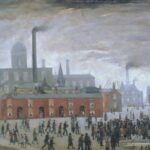The great artists infused their works with a genius for form, colour, composition, as well as meaning.. Much has been made of the tones used by van Gogh in his oeuvres, with speculation associating his vibrant palette to mental disease. The placement of the disciples and Christ in The Last Supper of Leonardo is almost an exercise in formal geometry; and who can be blind to the suffering that is everywhere in Goya’s Black Paintings?
But we know that from treatises on art history or our own viewing of the masterworks. What fewer people know is that some of the greatest painters and sculptors hid secret meanings or messages within their works.
Michelangelo’s David is terrified
A masterpiece of classical form, Michelangelo’s biblical hero David deftly captures masculine beauty. The statue is an exercise in calm courage; it is the climax of the hero’s contemplation to fight the giant Goliath. It captures the moment of resolve as David steels himself for the violent task that lies before him.
At least this is what most viewers see as they look up at the five meter tall statue. However, some say that if you could look down upon David, you would get a very different impression: David looks terrified. His steeled, stoic expression is replaced by a look of uncertainty and fear. Michelangelo sculpted fear into every part of the statue; David’s famously small penis is less a product of Renaissance statuary convention and more so the sum behaviour of physiological terror.
All things considered, being terrified is a perfectly acceptable reaction when one is about to engage in mortal combat with murderous giant.
How many people are in this painting?
The Arnolfini Portrait is a complex painting of a simple subject: a marriage of a rich merchant to his betrothed. Art critics can go on for hours about the innovation and complexity of this piece: its unique, orthogonal perspective, the use of light to highlight space, numerous glazes to bring out the sumptuous riches of the wedding chamber. But the artists himself drew more than just the happy couple. If you take a closer look at the mirror, you will see two more persons reflected therein: one is the artist himself, his hand raised in greeting; the other is a mysterious unknown figure.
The da Vinci (music) code
While the various theories posited by Dan Brown in his book The Da Vinci Code are rather silly, there is another work of da Vinci’s that does contain a hidden code: The Last Supper contains a musical composition mapped out by the position of loaves on the table in concert with the hands of Jesus and the apostles.
The resulting music is exceptionally harmonious and well formed – even sceptics are convinced that this was a deliberate intention of da Vinci.
The ninja whale
It was a student who thought the crowd gathered on an empty beach in a Hendrick van Anthonissen’s beach shore landscape to be out-of-place. Sure enough, restoration work revealed that the object of the crowd’s attention had been painted over – perhaps in a bid to make the painting more marketable.
The missing feature was in fact a whale who the crowd and boats were attempting to save. The ninja whale has since been given pride of place in the restored work.
Death in plain sight
L.S. Lowry was an artist whose works were dismissed as without merit during his lifetime, to rise in prominence posthumously. Lowry is now famous for paintings of bleak, industrialised landscapes peopled with beyond-ordinary equally bleak figures. The frenetic activity of his works masked deeper tragic scenes which can only be discerned on close inspection. An example of one is his 1926 work The Accident. A viewer cannot at first glance determine anything that would earn this painting its name. But, with careful inspection, one can see figures milling about a stretch of water in which the water-logged corpse of a suicide is being drawn.
There are many more examples of hidden meanings in paintings. Browse through bidorbuy’s wealth of art works to see if you can discover a special meaning in them, whether that was the artist’s intention or not.
You will surely find one or two works that you will want to buy and contemplate every day!












